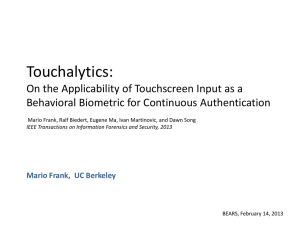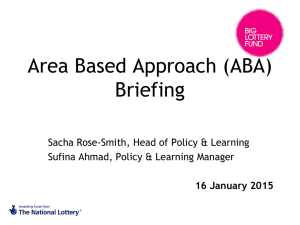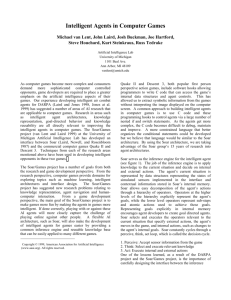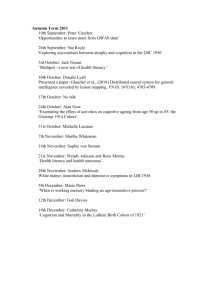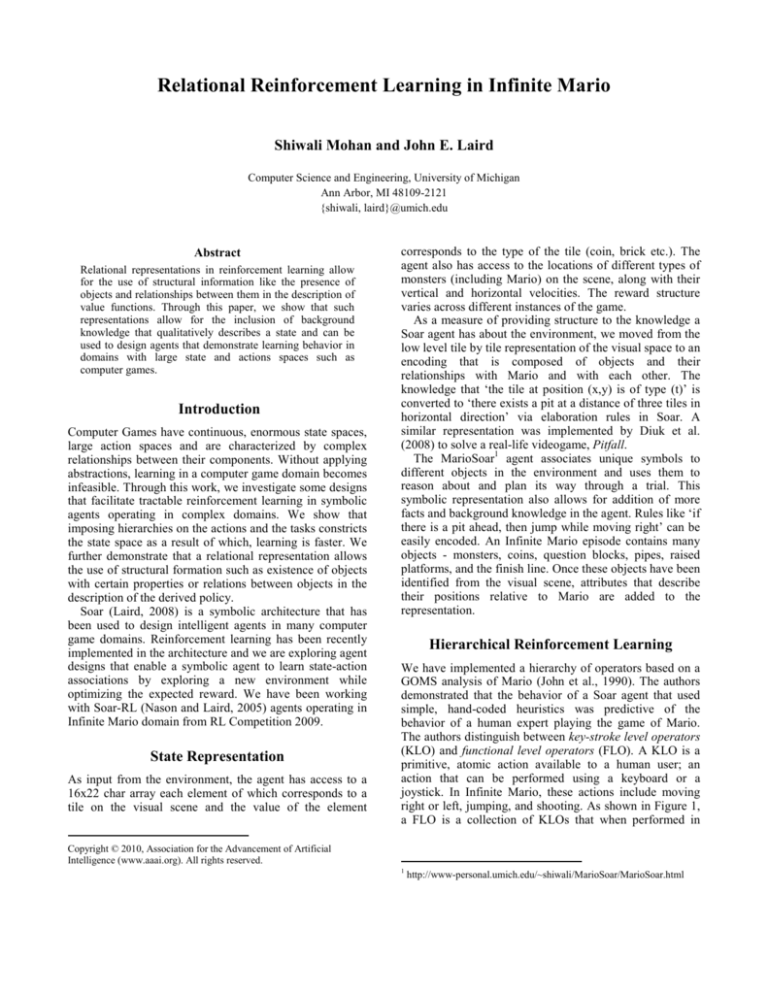
Relational Reinforcement Learning in Infinite Mario
Shiwali Mohan and John E. Laird
Computer Science and Engineering, University of Michigan
Ann Arbor, MI 48109-2121
{shiwali, laird}@umich.edu
Abstract
Relational representations in reinforcement learning allow
for the use of structural information like the presence of
objects and relationships between them in the description of
value functions. Through this paper, we show that such
representations allow for the inclusion of background
knowledge that qualitatively describes a state and can be
used to design agents that demonstrate learning behavior in
domains with large state and actions spaces such as
computer games.
Introduction
Computer Games have continuous, enormous state spaces,
large action spaces and are characterized by complex
relationships between their components. Without applying
abstractions, learning in a computer game domain becomes
infeasible. Through this work, we investigate some designs
that facilitate tractable reinforcement learning in symbolic
agents operating in complex domains. We show that
imposing hierarchies on the actions and the tasks constricts
the state space as a result of which, learning is faster. We
further demonstrate that a relational representation allows
the use of structural formation such as existence of objects
with certain properties or relations between objects in the
description of the derived policy.
Soar (Laird, 2008) is a symbolic architecture that has
been used to design intelligent agents in many computer
game domains. Reinforcement learning has been recently
implemented in the architecture and we are exploring agent
designs that enable a symbolic agent to learn state-action
associations by exploring a new environment while
optimizing the expected reward. We have been working
with Soar-RL (Nason and Laird, 2005) agents operating in
Infinite Mario domain from RL Competition 2009.
State Representation
As input from the environment, the agent has access to a
16x22 char array each element of which corresponds to a
tile on the visual scene and the value of the element
corresponds to the type of the tile (coin, brick etc.). The
agent also has access to the locations of different types of
monsters (including Mario) on the scene, along with their
vertical and horizontal velocities. The reward structure
varies across different instances of the game.
As a measure of providing structure to the knowledge a
Soar agent has about the environment, we moved from the
low level tile by tile representation of the visual space to an
encoding that is composed of objects and their
relationships with Mario and with each other. The
knowledge that ‘the tile at position (x,y) is of type (t)’ is
converted to ‘there exists a pit at a distance of three tiles in
horizontal direction’ via elaboration rules in Soar. A
similar representation was implemented by Diuk et al.
(2008) to solve a real-life videogame, Pitfall.
The MarioSoar1 agent associates unique symbols to
different objects in the environment and uses them to
reason about and plan its way through a trial. This
symbolic representation also allows for addition of more
facts and background knowledge in the agent. Rules like ‘if
there is a pit ahead, then jump while moving right’ can be
easily encoded. An Infinite Mario episode contains many
objects - monsters, coins, question blocks, pipes, raised
platforms, and the finish line. Once these objects have been
identified from the visual scene, attributes that describe
their positions relative to Mario are added to the
representation.
Hierarchical Reinforcement Learning
We have implemented a hierarchy of operators based on a
GOMS analysis of Mario (John et al., 1990). The authors
demonstrated that the behavior of a Soar agent that used
simple, hand-coded heuristics was predictive of the
behavior of a human expert playing the game of Mario.
The authors distinguish between key-stroke level operators
(KLO) and functional level operators (FLO). A KLO is a
primitive, atomic action available to a human user; an
action that can be performed using a keyboard or a
joystick. In Infinite Mario, these actions include moving
right or left, jumping, and shooting. As shown in Figure 1,
a FLO is a collection of KLOs that when performed in
Copyright © 2010, Association for the Advancement of Artificial
Intelligence (www.aaai.org). All rights reserved.
1
http://www-personal.umich.edu/~shiwali/MarioSoar/MarioSoar.html
succession, perform a specific task related to an object,
such as killing a monster, or grabbing a coin.
Functional Level Operators (FLOs)
moveright
grabcoin
move
right/left/stay
search
-block
jump
yes/no
avoidpit
close vicinity of Mario, the agent chooses to deal with the
nearby monster first, because a failure to do so would
result in the termination of the game. Note, that this
knowledge is learned over successive trials of the game.
tacklemonster
speed
High/low
Results
Figure 2 shows the Soar-RL agent’s performance as it
learns selection knowledge for both the FLO’s and the
KLO’s, in comparison to a hand-coded sample agent that
was distributed with the Mario environment.
Figure 1: Operator Hierarchy
The GOMS analysis makes two important observations:
to successfully complete a game only a small set of FLOs
are necessary, all of which can be readily identified; and
human experts use local conditions to select between the
applicable FLOs. In our implementation, we converted
distance between Mario and other entities on the screen to
attributes like isthreat (for monsters), isreachable (for
coins and blocks) through elaboration rules. This
qualitative information is then used by the agent to make a
selection from the group of proposed FLOs.
Soar operators are proposed whenever they can be
legally applied. For example, tackle-monster FLO is
proposed when a monster is close by and the attribute
isthreat is yes. A FLO proposal causes creation of a
substate, in which KLOs are proposed and the agent
performs a series of atomic actions. The agent moves out
of a substate when the object that caused it is no longer
present, which in this case is when Mario kills the monster.
Soar RL rules generate numeric preferences for operators.
In case of a tie, where multiple objects cause proposals of
different operators, the agent uses the numerical
preferences associated with the operators to break the tie;
the operator with the largest numerical preference is
selected and applied.
Our implementation differs from the GOMS analysis in
that the agent learns these preferences through its
reinforcement learning mechanism whereas the preferences
in GOMS analysis were hand-coded by the programmer
based on the instruction booklet of the game. The
numerical preference is closely linked to the value function
for a given state and the proposed operator. We have used
SARSA (Rummery and Niranjan, 1994) for Soar agents for
this domain.
The agent learns at two distinct levels; at a higher level,
the agent learns to select between FLOs when multiple
choices present themselves. Once a FLO has been selected
to be employed, the agent also learns to select between the
correct KLOs to successfully complete the current subtask.
This formulation divides the game into several subtasks
of collecting a coin, killing a monster etc. FLOs proposed
in a given state allow the agent to interact with
corresponding objects in the environment. The agent
selects between the FLOs based on which interaction is
most immediate. For example if a coin and a monster are in
Reward
Keystroke Level Operators (KLOs)
160
140
120
100
80
60
40
20
0
Soar RL Agent
Sample Agent
0
200
400
600
800
1000
Episodes
Figure 2: Performance of Soar Rl agent and Sample Agent in
level type 0, difficulty 0
Conclusions and Future Work
The current agent design assumes that the agent can
interact with different objects in its vicinity independently.
This assumption holds in scenarios where interacting with
one object holds more importance than dealing with other
near-by objects, e.g. when a coin and a monster are in
vicinity, dealing with the monster holds precedence over
grabbing the coin. However when, multiple objects have
similar importance, e.g. when two monsters are nearby; the
assumption breaks down and the agent fails to learn any
useful strategy.
We are currently looking at the problem in addition to
learning operator preferences, the agent learns new
operators and rules as novel situations present themselves.
References
Laird, J. E. 2008. Extending the Soar Cognitive Architecture. In
Proceedings of the First Conference on Artificial General
Intelligence. Memphis, TN.
Nason, S., and Laird, J. 2005. Soar-RL, integrating reinforcement
learning with Soar. In Proceedings of the sixth international
conference on cognitive modeling. Pittsburg, PA.
Diuk, C., Cohen, A., and Littman, M. L. 2008. An object-oriented
representation for efficient reinforcement learning. In
Proceedings of the Twenty Fifth International Conference on
Machine Learning, Finland.
John, B.E., Vera, A. H., and Newell, A. 1990. Towards Real-time
GOMS. Technical Report, CMU-SCS-90-95, School of Computer
Science, Carnegie Mellon University.
Rummery, R. A., Niranjan, M. 1994. Online Q-Learning Using
Connectionist
Systems.
Technical
Report,
CUED/FINFENG/TR166, Cambridge University.





